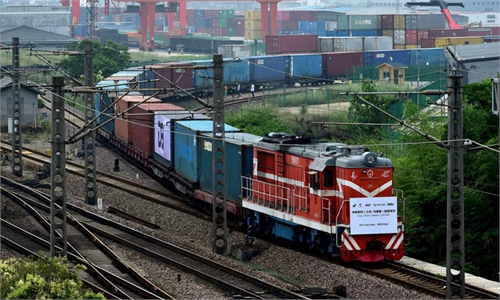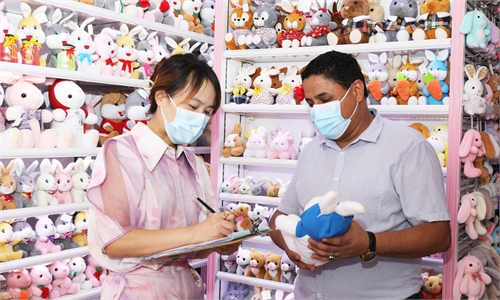
A Yemeni merchant is introducing prices of teapots to Saudi Arabian customers via video at Yiwu International Trade City in Yiwu, East China's Zhejiang Province.File photo:Xinhua
Chinese international traders are dealing with sluggish global consumption through measures such as organizing chartered flights, as foreign orders felt the impact of a weakened world economy due to inflation, geopolitical conflicts and other factors.As an early sensor of global inflation, traders at Yiwu, East China's Zhejiang Province, saw orders from foreign clients decline sharply, especially from the US, where fears of higher inflation remain.
The cost of a forty-foot equivalent unit (FEU) container between Chinese ports and the US west coast has plummeted from over $20,000 in peak time to around $3,400 today, the Global Times learned from several industry insiders.
But even though an FEU container to the US west coast has come down to a new low, traders like Zhou Peng, a manager with the Yiwu Pengyuan International Freight Forwarder based in Yiwu, are not interested.
"The amount of overseas orders dropped by around 50 percent in August year-on-year," Zhou said, and he predicted that such a drop is likely to continue in September, a peak time for international traders in ordinary times, because of global inflation.
But Zhou and his company are beefing up ways to deal with the impact of the weak global market, including via active coordination with foreign clients and producers in advance.
While the freight rate of ocean shipping routes has fallen in the short term, it is still at a high level in the medium and long term, which means there is still lingering pressure for traders to balance the costs as orders drop, insiders said.
A recent survey conducted by the China Council for the Promotion of International Trade of more than 500 enterprises showed that the main difficulties facing enterprises are slow logistics, high costs and few orders.
Some 56 percent of the surveyed companies said that raw material prices and logistics costs are high, and 62.5 percent of the companies said that orders are not stable, according to media reports.
The plummeting freight rate, best represented by the significant drop of orders from the US coast, have indicated the global trend of inflation, Zhong Zhechao, founder of One Shipping, an international logistics service consulting company, told the Global Times on Sunday.
"Shipping companies have also adjusted their businesses by cutting transport capacity and some transport routes to reduce costs but the freight rate is still going down," Zhong said, predicting that the shipping revenue of some shipping companies may be cut by around 80 percent next year compared with the peak time of this year due to supply outstripping demand.
To help local businesses deal with the tough situation, local governments have ramped up measures with tangible actions already in place, such as organizing chartered flights for foreign clients coming to China while continuing to do a good job in epidemic control, media reported. Chinese business groups are also going abroad to meet their clients in person.
In the past few months, local authorities in Zhejiang have formed a complete workflow, with more than 10 chartered flights set to depart from places such as Jiaxing and Yiwu in the province to other countries and regions to facilitate trade deals, according to media reports.
"The government has recently organized chartered flights to help foreign companies come in to purchase, or Chinese companies to go out, which reflects the fact that the relevant authorities have seen the decline in data, and are doing their best to introduce policies, hoping to help local and international businesses out," Zhong said.
Zhong predicted that while the overall freight rate is going down, with some FEU possibly even dropping below $3,000, the overall rate will gradually return to the level before the epidemic after supply and demand reach a balance next year.



